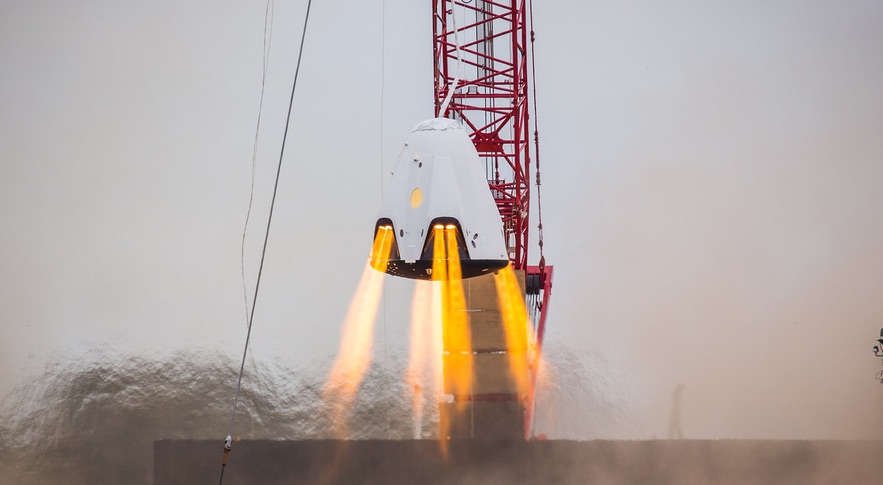
WASHINGTON — A SpaceX executive May 3 provided new details about, but no cause of, an incident that destroyed a Crew Dragon spacecraft during a ground test last month.
Hans Koenigsmann, vice president of build and flight reliability at SpaceX, said at a NASA briefing about the upcoming launch of a cargo Dragon spacecraft to the International Space Station that the anomaly took place just before the ignition of the SuperDraco thrusters on the spacecraft during an April 20 test at the company’s Landing Zone 1 at Cape Canaveral Air Force Station in Florida.
Koenigsmann said that the spacecraft had, earlier in the day, completed other tests on the stand, including of its smaller Draco thrusters. “Just before we wanted to fire the SuperDracos, there was an anomaly and the vehicle was destroyed,” he said.
He declined to speculate on the cause of the accident. “It is too early to confirm any cause, whether probable or root,” he said. “The initial data indicates that the anomaly occurred during the activation of the SuperDraco system.” The activation of the thrusters takes place about a half a second before ignition. He added, though, that he didn’t think the problem was with the SuperDraco thrusters themselves, citing “about 600 tests” of the thrusters over the course of its development.
He later said it was unlikely that the incident had anything to do with composite-overwrapped pressure vessels, or COPVs, that are part of the propulsion system. The design of a COPV used on the Falcon 9’s second stage was blamed for an explosion during preparations for a static-fire test of the rocket in September 2016, leading to a redesign of that pressure vessel.
“The COPVs are different from Falcon 9. These are different in material, they have a different form,” he said. “I’m fairly confident that the COPVs are going to be fine.”
Koenigsmann said the company is currently focused on the investigation into the mishap, and declined to estimate how much of an impact it will have on the schedule of upcoming test flights. SpaceX had planned to perform an in-flight abort test using the Crew Dragon spacecraft destroyed in the anomaly as soon as June, followed by a crewed test flight no earlier than July.
“Finishing the investigation and resolving this anomaly is actually our prime focus, certainly for me, right now,” he said. “I hope this is a relatively swift investigation at the end of the day, and I don’t want to completely preclude the current schedule.”
He didn’t say how the capsule lost in the test mishap, which flew on the Demo-1 mission to the station, would be replaced for the in-flight abort test. He noted SpaceX has “multiple spacecraft” in various stages of production, which he said should mitigate any effect the loss of this capsule will have on the test flight schedule.
Koenigsmann spoke at a briefing NASA held prior to the scheduled May 3 launch of a cargo Dragon spacecraft on a mission to the International Space Station. The launch was previously scheduled for May 1 but postponed because of a problem with a switching unit that routes power on the station. Kenny Todd, NASA’s space station operations and integration manager, said the faulty unit was swapped out by controllers using the station’s robotic arm, clearing the way for the launch to proceed.
Todd also said that NASA worked closely with SpaceX to confirm that there was no commonality between the systems involved in the Crew Dragon anomaly and those on the cargo Dragon. “We were able to get our arms around the common areas that we had to look at, that they had to look at,” he said. “At the end of the day, we didn’t see any change in our overall measurable risk in going into the mission.”
This cargo Dragon, flying a mission designed CRS-17, previously flew to the station on the CRS-12 mission in August 2017. The spacecraft will carry 2,482 kilograms of cargo, of which about 1,700 kilograms is in the form of science payloads, including those to be mounted on the station’s exterior.
Liftoff of the CRS-17 mission is scheduled for 3:11 a.m. Eastern May 3, but forecasts predict only a 40 percent change of acceptable weather because of an approaching system. Forecasts improve to 70 percent for a backup launch date May 4 at 2:48 a.m. Eastern. Todd said that, should the launch not take place in either instantaneous launch window, NASA and SpaceX would have to wait a week before the next attempt because of scheduled downtime on the Eastern Range.
Bagikan Berita Ini














0 Response to "SpaceX offers new details on Crew Dragon test anomaly - SpaceNews"
Post a Comment